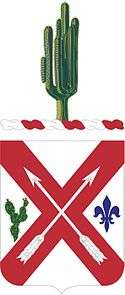158th Infantry Regiment (United States)
| 158th Infantry Regiment | |
|---|---|
|
Coat of arms | |
| Active |
1865-1967 2005 – present |
| Country |
|
| Allegiance |
|
| Branch | Arizona Army National Guard |
| Type |
Infantry |
| Nickname(s) | Bushmasters (special designation)[1] |
| Motto(s) | Cuidado (Take Care) |
| Engagements |
Indian Wars Mexican Expedition World War I World War II War in Afghanistan |
| Commanders | |
| Current commander | LTC David Pidone |
| Command Sergeant Major | CSM Daniel Figueroa |
| Notable commanders | Hanford MacNider |
| Insignia | |
| Distinctive unit insignia |
 |
| U.S. Infantry Regiments | |
|---|---|
| Previous | Next |
| 157th Infantry Regiment | 159th Infantry Regiment |
The 158th Infantry Regiment ("Bushmasters"[1]) is an infantry unit of the Arizona National Guard. The regiment has served abroad in World War I, World War II and Afghanistan.
In 1967 then Governor of Arizona Jack Williams signed into law that 3 December would be "Bushmaster Day" in the State of Arizona in honor of the regiment's service.
History
The 158th Infantry takes its lineage directly from the Confederate Arizona Scout Companies raised by Arizona Territory Governor, John Robert Baylor[2] The Arizonians engaged in hit and run tactics against the invading Union forces of the California Column, their most successful encounter being the Battle of Picacho Pass. However Confederate forces were soon forced to abandon Arizona and retreat into Texas. The Arizona Scout Companies formed under the command of Lt. Col. Philemon T. Herbert and would continue to fight through the war until Southern defeat in 1865. Returning Civil War veterans and citizens formed on 2 September 1865 the 1st Arizona Volunteer Infantry part of Arizona Army National Guard. It participated in a number of campaigns against the Apache during the Apache Wars and comprised companies of Maricopa and Pima American Indians.
During the Spanish–American War the unit adopted as the motto "Cuidado" a Spanish word meaning "take care" in reference to when they would patrol for them to be on guard. However later the term would be applied far more liberally when the 158th was conducting jungle warfare training in Panama and the deadly pit viper from which they drew their nickname infested the jungle, from here Bushmasters would tell each other to beware of the snake. In 1916, during the Pancho Villa Expedition, an expeditionary force led by General John Pershing into Mexico, the 1st Arizona Volunteer Infantry guarded and patrolled the border between Douglas and Naco, Arizona until World War I was declared on 6 April 1917.
World War I
The 1st Arizona Volunteer Infantry was drafted into federal service 5 August 1917, re-designated as the 158th Infantry Regiment (1st Arizona Infantry) as part of the 79th Brigade, of the 40th Division and was sent overseas to France in August 1918. The regiment saw no active service at the front, however its men furnished replacement personnel to other units and was honored by acting as guard of honor to President Woodrow Wilson during his visit in France in 1918 with the 158th Infantry Band chosen as Wilson’s honor band. The regiment was inactivated as a federal unit on 3 May 1919.
Inter-War period
In 1924,[3] F Company was formed as an all-native American unit made up of alumni of the Phoenix Indian School.[4]
World War II
After the national army reorganization after World War I, the regiment was assigned to the 45th Infantry Division. At the outbreak of World War II, the unit was activated into Federal service on 16 September 1940 and started training at Fort Sill, Oklahoma. The regiment then moved to Camp Barkeley, Texas in February 1941 and conducted maneuvers in Louisiana. After the United States declared war on 8 December 1941, the unit was detached from the 45th Division and was sent to Panama for jungle training and protection of the Panama Canal Zone arriving 2 January 1942.This was done as the "square" divisions of the Army National Guard were being transitioned to the triangular division TO&E in 1942, they each "shed" an infantry regiment, leaving several trained and operational "orphan" regiments available for independent service. Unlike other regiments which were relinked to form new divisions the 158th was left alone, either because of its location or the diversity within its ranks of ethnic groups that weren't desired by most line commanders. The regiment adopted the name Bushmasters after the venomous pitvipers found in South America, replacing the name "1st Arizona Infantry". Each combat soldier in the regiment received extensive training in jungle warfare, knife fighting, and unarmed hand-to-hand combat techniques.[5]
With the formation of the 6th Army, led by General Walter Krueger, and allocation of the 158th Regiment to the 6th Army, the Bushmasters were sent to Brisbane, Australia arriving on 16 January 1943. When the 6th Army's headquarters moved to Goodenough Island, New Guinea the 2nd Battalion, 158th Regiment provided security to the headquarters. The 158th Regiment less 2nd Battalion landed on the unoccupied island of Kiriwina, New Guinea as part of Operation Chronicle, on 30 June, for the purposes of occupying the island for the construction of an advanced base and airfield. The regiment was spread out between Kiriwina, Woodlark and Goodenough Islands in New Guinea
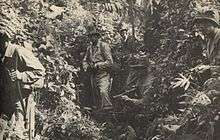
Company G, 158th Regiment embarked for Arawe, New Britain on 15 December, as part of Operation Director and was soon joined by the remainder of the 2nd Battalion and began combat duties in the Arawe area. After being relieved at Arawe, the 2nd Battalion sailed to Finschhafen, where they rejoined the 1st and 3rd Battalions who had been on garrison duty on Woodlark and Kiriwina islands. At Finshaffen, the 158th Regiment was redesignated the 158th Regimental Combat Team. A 1943 article in Popular Mechanics recorded the abilities of the individual Bushmaster jungle soldier:[5]
"One of America's most colorful and least known soldiers of World War II is the Bushmaster...His tactics are borrowed from native jungle fighters, the American Indian, British commandos, exponents of judo and the Shanghai underworld...(He uses) machetes, curved knives, tommy guns, high-powered rifles, and hand grenades...His average age is 22 and his favorite weapon is the long-bladed machete...With his fellow Bushmasters, he disappears from civilization for weeks at a time. The men know how to sustain themselves on wild fare supplemented by (jungle rations) carried in their packs. When they are not testing their camouflage against aerial observers, making camp in a swamp, or working out an intricate code of communications, they are practicing jujitsu or improve on the native's technique with the machete. The Bushmaster bows to no man in the art of hand-to-hand fighting and any unwary (enemy) who crosses his path would probably never know what hit him."[5]
Sent to Wakde, Netherlands New Guinea to relieve the 163rd Regimental Combat Team of the 41st Division arriving at Toem on 21 May 1944. The regimental combat team tasked with taking Sarmi, fought a major battle at Lone Tree Hill against the Imperial Japanese 36th Division between 17 May to 12 June, before being relieved by the 6th Infantry Division.
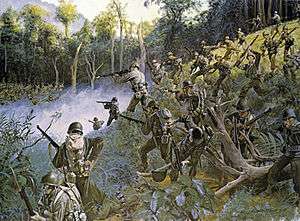
On 2 July, the regimental combat team went ashore as part of the battle of Noemfoor on Noemfoor Island, Netherlands New Guinea, to capture the airfields and to provide security for the engineers upgrading the airfields to operational use. As part of General Douglas MacArthur's return to the Philippines, the regimental combat team under the command of the much respected and admired General Hanford MacNider landed at Lingayen Gulf, Luzon as part of the invasion of Lingayen Gulf on 11 January 1945 and suffered heavy casualties from well dug in Japanese forces along the Damortis-Rosario road. Company G, was awarded a Presidential Unit Citation after destroying a Japanese 14-inch coastal gun which was directing heavy fire on the Allied ships. The entire regiment would be awarded the Philippine Presidential Unit Citation for its fighting in the Philippines.
The next objective tasked to the regimental combat team was Batangas, Luzon where they cleared the area around Balayan Bay and Batangas Bay, which took three weeks to subdue. The aided by the Filipino ground troops of the Philippine Commonwealth Army and Philippine Constabulary were welcomed to helped by the regimental combat team was engage or the liberated areas in Southern Luzon and Bicol Peninsula against the Japanese Imperial forces. Then on 1 April, the regimental combat team invaded the Bicol Peninsula, landing at Legaspi. F Company was made up most of Native Americans from the main tribes of the Salt River Valley, but was led by white officers. Many of these officers, who survived combat, later recounted participating in Native American rituals; such as becoming blood brothers and purifying their warrior's spirit before battle. Although these rituals are not today performed by the majority of the unit's soldiers, they still use Japanese saki to toast with in reference to the supply captured by the regiment during its time in the Philippines. After being relieved in Philippines campaign, the regiment was selected as part of the planned Operation Downfall, the invasion of Japan, the Bushmasters were chosen to attack the island of Tanegashima to capture the island's air warning stations two days prior to the Allied assault on Kyūshū. The atomic bombing of Hiroshima and Nagasaki caused the surrender of the Japanese on 14 August 1945. On 13 October 1945, the regimental combat team landed in Yokohama, Japan to be part of the Occupation of Japan. The 158th Regimental Combat Team was deactivated at Utsunomiya, Japan, on 17 January 1946.
General MacArthur gave the Bushmasters the accolade, "No greater fighting combat team has ever deployed for battle".[6]
1948 to today
The regiment was reactivated on 21 January 1948 at Glendale, Arizona. Later reorganized and redesignated as the Heavy Mortar Company, 158th Infantry, and then Combat Support Company, 1st Battle Group, 158th Infantry. The unit was then reorganized and redesignated as Headquarters and Headquarters Company, 3rd Battalion, 158th Infantry, 258th Infantry Brigade on 1 March 1963 and again on 10 December 1967 to Headquarters and Headquarters Company, 1583rd Military Police Battalion, 258th Military Police Brigade. It was again redesignated on 1 September 1969 as Headquarters and Headquarters Company, 157th Military Police Battalion. In 1967 however despite protest from veterans and soldiers, the last remnants of the 158th IN were disbanded and their colors retired.
In 2005, the 1st Battalion, 180th Artillery was deactivated and redesignated the 1st Battalion, 158th Infantry Regiment, 29th Infantry Brigade with five companies: Headquarters and Headquarters Company in Mesa (since moved to Phoenix); Company A in Tucson, Company B in Gilbert (since moved to Florence); Company C in Prescott; and Company D in Yuma (since moved to Buckeye). In January 2007, 1st Battalion, 158th Infantry Regiment was mobilized and deployed to Afghanistan in April of that year. During that time the battalion was posted to the southeastern area of the country near the border of Pakistan in the Hindu Kush. During this deployment two Bushmasters were killed and others wounded during combat operations. 1-158th returned to the United States in March 2008.
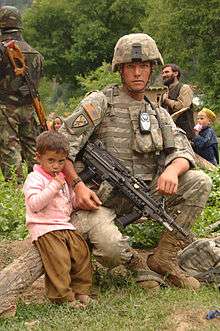
Operationally the 158th Infantry Regiment falls under the authority of the 29th Infantry Brigade Combat Team. Although the 29th's headquarters is located in Hawaii, the 29th is one of 15 enhanced readiness brigades, with a training requirement to remain capable of being called up and deployed in less than 90 days.
Campaign streamers
Campaign credit
| Conflict | Streamer | Year(s) |
|---|---|---|
| Indian Wars |
Arizona | 1866 |
| World War I |
Without Inscription | 1918 |
| World War II |
New Guinea with Arrowhead | 1943-44 |
| Bismarck Archipelago | 1943 | |
| Luzon with Arrowhead | 1944-45 | |
| Northern France Campaign | 1944 | |
| Battle of the Rhineland | 1945 | |
| Central Europe Campaign | 1945 | |
| Afghanistan |
OEF VIIII | 2007-08 |
- (Streamers for the European Campaign are from the regiment's consolidation with other units, all other streamers have their origins solely with the 158th)
Decorations
| Ribbon | Award | Year | Notes |
|---|---|---|---|
| Presidential Unit Citation (Army) | 1945 | Lingayen Gulf: G Co. | |
| Meritorious Unit Commendation (Army) | Southwest Asia: HHC, D Co. | ||
| Philippine Republic Presidential Unit Citation | 1944–1945 | Liberation of the Philippines |
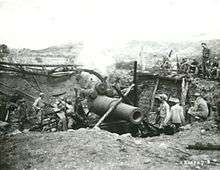
Distinctive unit insignia
- Description
A gold color metal and enamel device 1 5/32 inches (2.94 cm) in height overall consisting of a blue shield charged with a Gila monster bendwise, head to base. Attached below the shield is a blue scroll inscribed "CUIDADO" in gold.
- Symbolism
The service of the former and current organization, the 158th Infantry Regiment is indicated by the Gila monster, indigenous to the State of Arizona, which is emblematic of tenacity and security. The color blue represents Infantry. It is also symbolic of loyalty and faith. The motto "CUIDADO" (Take Care) is both a warning and a caution. A warning to those who oppose the Regiment and a caution to those who belong to it.
- Background
The distinctive unit insignia was originally approved for the 158th Infantry Regiment, Arizona National Guard on 22 July 1924. It was amended to authorize its wear in pairs on 11 April 1926. It was amended to prescribe wear by enlisted personnel on the lapel collar coat on 25 April 1928. It was amended to change the description on 24 July 1930. It was redesignated for the 1581st Military Police Battalion, Arizona Army National Guard on 14 August 1969. The insignia was redesignated for the 158th Military Police Battalion, Arizona Army National Guard on 26 September 1969. It was redesignated for the 153d Field Artillery Group, Arizona Army National Guard on 4 August 1976. It was redesignated for the 153d Field Artillery Brigade, Arizona Army National Guard on 9 January 1979. The insignia was cancelled on 30 March 1998. It was redesignated for the 158th Regiment, Arizona Army National Guard with description and symbolism revised on 7 May 1998. The insignia was redesignated for the 158th Infantry Regiment, Arizona Army National Guard with symbolism revised on 22 November 2005.
Coat of arms
- Blazon
- Shield- Argent on a saltire Gules two arrows crossed of the field, in dexter fess a prickly pear cactus Vert and in sinister fess a fleur-de-lis Azure.
- Crest- That for regiments and separate battalions of the Arizona Army National Guard: From a wreath Argent and Gules, a giant cactus Proper.
- Motto: CUIDADO (Take Care).
- Symbolism
- Shield- The service of the former and current organization, the 158th Infantry Regiment, is indicated by the white shield, which represents Infantry. The red saltire cross recalls the fact that the regiment was organized in 1865, under an order from the Provost Marshal General of the United States, and under authority granted for the raising of troops for the Civil War. The arrows indicate the regiment’s early service in fighting the Apache Indians. The motto has two meanings or rather two applications – a warning to those who might oppose the Regiment and a caution to those who belong to it.
- Crest- The crest is that of the Arizona Army National Guard.
- Background- The coat of arms was originally approved for the 158th Infantry Regiment, Arizona Army National Guard on 26 July 1924. It was redesignated for the 1581st Military Police Battalion, Arizona Army National Guard on 14 August 1969. It was redesignated for the 158th Military Police Battalion, Arizona Army National Guard on 26 September 1969. It was redesignated for the 158th Regiment, Arizona Army National Guard on 29 April 1998. The insignia was redesignated for the 158th Infantry Regiment, Arizona Army National Guard with symbolism revised on 22 November 2005.
See also
- Coats of arms of U.S. Infantry Regiments
References
![]() This article incorporates public domain material from the United States Army Institute of Heraldry document "158th Infantry Regiment".
This article incorporates public domain material from the United States Army Institute of Heraldry document "158th Infantry Regiment".
- 1 2 "Special Designation Listing". United States Army Center of Military History. 21 April 2010. Archived from the original on 9 June 2010. Retrieved 14 July 2010.
- ↑ Frazier, Donald S."Blood & Treasure:Confederate Empire in the Southwest" Texas A&M Press, 1995, p.57
- ↑ Russ Blaise. "Alamo Scouts Photo Archives". The Alamo Scouts Association. Retrieved 8 June 2011.
Company F, 158th Infantry, Arizona National Guard, prior to Federalization on 16 September 1940. The company was organized in 1924 as the only all-Indian company in the U.S. Army.
- ↑ Meadows, William C (2002). The Comanche code talkers of World War II. Austin, Texas: University of Texas Press. p. 39. ISBN 978-0-292-75274-0. Retrieved 8 June 2011.
- 1 2 3 Whittaker, Wayne, Tough Guys, Popular Mechanics, February 1943, Vol. 79 No. 2, pp. 41, 44–45
- ↑ Melton, Brad; Dean Smith (1 May 2003). Arizona Goes to War: The Home Front and the Front Lines During World War II. University of Arizona Press. p. 85. ISBN 978-0-8165-2189-0. Retrieved 9 November 2012.
- Bushmasters History
- Martin Hardwick Hall, The Confederate Army of New Mexico, Austin, Texas: Presidial Press, 1978, pp 353–355 and 367-369.
- L. Boyd Finch, Confederate Pathway to the Pacific: Major Sherod Hunter and Arizona Territory, C.S.A., Tucson, Arizona: Arizona Historical Society, 1996, p. 171.
External links
- Suggested Reading on the 158th Infantry compiled by the United States Army Center of Military History
